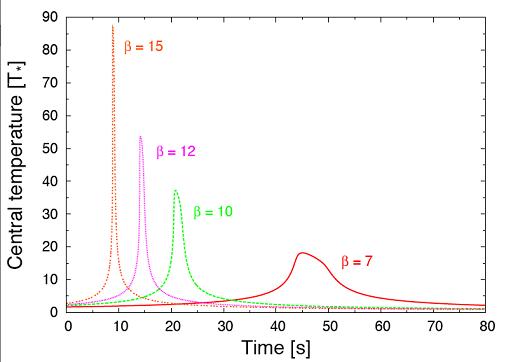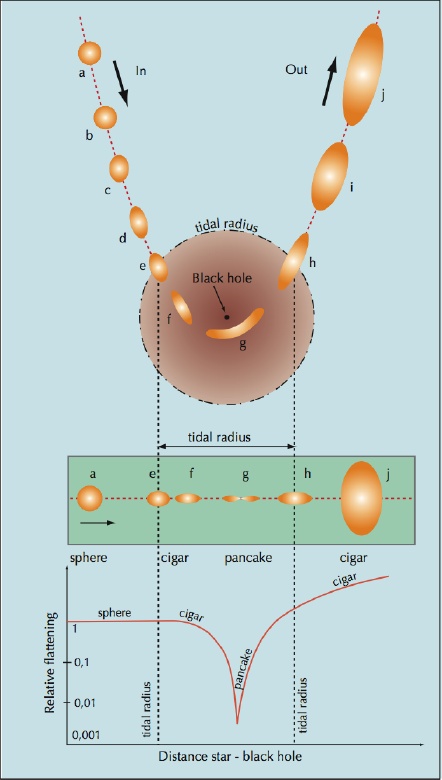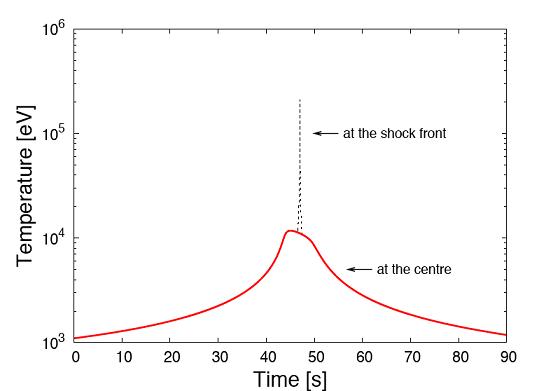It makes sense that massive black holes lurking in galactic nuclei and weighing millions of Suns can disrupt stars that come too close. Astrophysicists say that the black hole’s gravity pulls harder on the nearest part of the star, an imbalance that pulls the star apart over a period of hours, once it gets inside the so-called "tidal radius."
Two astrophysicists from Paris Observatory say the fate of stars that venture too close to massive black holes could be even more violent than previously believed. Not only are they crushed by the black hole’s huge gravity, but the process can also trigger a nuclear explosion that tears the star apart from within. In addition, shock waves in the pancake star carry a brief and very high peak of temperature outwards, that could give rise to a new type of X-ray or gamma-ray bursts.
Yes, it's galactic flambé.

But Matthieu Brassart and Jean-Pierre Luminet of the Observatoire de Paris-Meudon won't let the food metaphor end there. Their computer simulations show that when the star gets close enough to the black hole (without falling in), the tidal forces flatten it into a pancake shape.
Previous studies already performed by Luminet and collaborators twenty years ago had suggested this flattening would increase the density and temperature inside the star enough to trigger intense nuclear reactions that would tear it apart. But other studies had suggested that the picture would be complicated by shock waves generated during the flattening process, and that no nuclear explosion should occur.
The new simulations investigate the effects of shock waves in detail, and find that even when their effects are included, the conditions favour a nuclear explosion which will completely destroy the star, and which will be powerful enough to hurl much of the star’s matter out of the black hole’s reach.

The tidal disruption of stars by black holes may already have been observed by X-ray telescopes such as GALEX, XMM and Chandra, although at a much later stage: several months after the event that rips the star apart, its matter starts swirling into the hole, heats up and releases ultraviolet light and X-rays.
However, if pancake stars really do explode, then they could in principle allow these events to be detected at a much earlier stage. Future observatories, such as the Large Synoptic Survey Telescope (LSST), which will detect large numbers of supernovae, could turn up some explosions of this type.
But this might be not the only hazard facing the doomed star. Brassart and Luminet calculated that the shock waves inside the stellar pancake carry a brief (< 0.1 s) but very high (above 10^9 K) peak of temperature outwards from the centre to the surface of the star. This last result is very promising since it could give rise to a new type of X-ray or gamma-ray burst, making it possible to see the disruption of the star immediately if it gets hot enough.
The rate of such "flambéed pancake stars" is estimated to be about 0.00001 event per galaxy. Since almost every galaxy – including our own Milky Way – harbors a massive black hole in its centre, and since the universe is transparent to hard X and gamma radiation, several events of this kind per year should be detectable within the full observable universe.

Conclusion
The planned high-energy, all-sky surveys are the best suited to detect more flares of this type because of their large sky coverage. By providing a quick localization of flambéed stellar pancakes, followed by the detection of the corresponding afterglows in the optical, infrared, and radio bands, these missions could bring as much to the understanding of stellar disruptions by black holes as the Beppo-Sax and Swift telescopes did for the comprehension of gamma-ray bursts.
REFERENCES:
Shock Waves in Tidally Compressed Stars by Massive Black Holes, M. Brassart & J.-P. Luminet, Astron. Astrophys. 481 (2008) 259-277
For a popular account of tidal disruption and massive black holes, see also J.-P. Luminet, Le destin de l’univers : trous noirs et énergie sombre, Fayard (Paris, 2006), chap.21






Comments